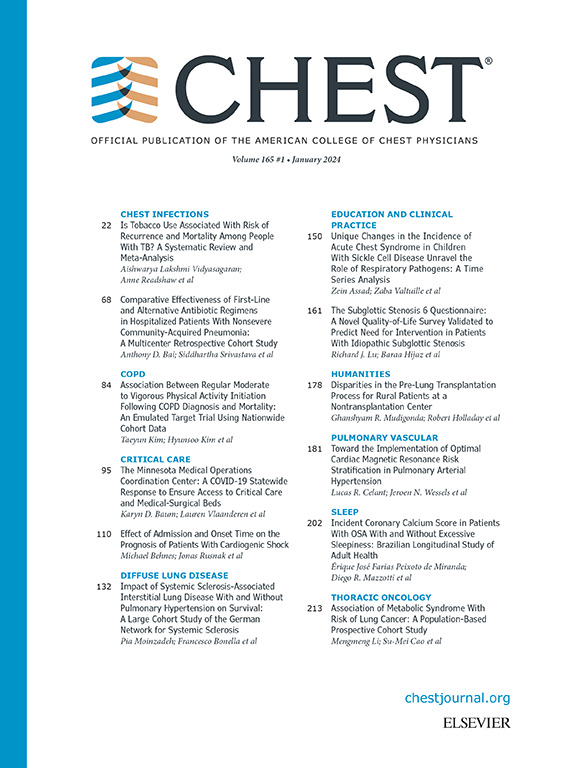Ventilatory Efficiency in Transgender Women: Implications of Gender-Affirming Hormone Therapy on Cardiorespiratory Responses.
IF 9.5
1区 医学
Q1 CRITICAL CARE MEDICINE
引用次数: 0
Abstract
BACKGROUND Ventilatory efficiency, a key parameter of cardiopulmonary function assessed through cardiopulmonary exercise testing (CPET), often demonstrates significant variability in transgender women due to the physiological changes induced by gender-affirming hormone therapy. Understanding these differences is essential for optimizing clinical management and enhancing health outcomes within this population. RESEARCH QUESTION How do ventilatory efficiency, particularly the carbon dioxide ventilatory equivalent (VE/VCO2), and other CPET variables differ between transgender women and matched cisgender controls, offering insights into the physiological impacts of gender-affirming hormone therapy? STUDY DESIGN AND METHODS This case-control study included 51 participants, comprising 17 transgender women matched 1:1:1 by age, body mass index, and physical activity levels with cisgender women and cisgender men. CPET assessments were conducted between August 2018 and September 2019, before the COVID-19 pandemic. RESULTS Transgender women demonstrated significantly higher VE/VCO2 ratios at rest (31.4 ± 2.9), at the first ventilatory threshold (34.9 ± 3.9), and peak exercise (39.3 ± 5.3) compared to cisgender women (28.2 ± 2.5; 31.8 ± 3.2; 35.4 ± 4.4, respectively) and cisgender men (27.4 ± 2.1; 30.8 ± 2.6; 34.3 ± 3.5, respectively), with all comparisons reaching statistical significance (p < 0.001) and large effect sizes (η2 = 0.30-0.34). The VE/VCO2 slope was also significantly elevated in transgender women (33.9 ± 4.2) compared to cisgender women (29.5 ± 5.0) and cisgender men (28.0 ± 3.5) (p < 0.001; η2 = 0.29), indicating reduced ventilatory efficiency across the effort continuum. INTERPRETATION This study highlights substantial ventilatory inefficiencies in transgender women, likely associated with gender-affirming hormone therapy, underscoring the need for tailored clinical strategies to address these cardiopulmonary adaptations. These findings provide critical insights into the unique health needs of transgender individuals, contributing valuable data to support evidence-based care.跨性别女性的通气效率:性别确认激素治疗对心肺反应的影响。
呼吸效率是通过心肺运动试验(CPET)评估心肺功能的一个关键参数,由于性别确认激素治疗引起的生理变化,跨性别女性的呼吸效率往往表现出显著的差异。了解这些差异对于优化临床管理和提高这一人群的健康结果至关重要。研究问题:跨性别女性与顺性别对照者的通气性,特别是二氧化碳通气性当量(VE/VCO2)和其他CPET变量有何不同,这为性别确认激素治疗的生理影响提供了新的见解?研究设计和方法本病例对照研究纳入51名参与者,包括17名变性女性,按年龄、体重指数和身体活动水平与顺性女性和顺性男性的比例为1:1:1。CPET评估是在2019冠状病毒病大流行之前的2018年8月至2019年9月进行的。结果异性别女性静止时(31.4±2.9)、首次通气阈时(34.9±3.9)和运动高峰时(39.3±5.3)的VE/VCO2比值明显高于顺性别女性(28.2±2.5);31.8±3.2;(35.4±4.4),顺性别男性(27.4±2.1);30.8±2.6;34.3±3.5),所有比较均具有统计学意义(p < 0.001),且效应量大(η2 = 0.30 ~ 0.34)。变性女性的VE/VCO2斜率(33.9±4.2)显著高于顺性女性(29.5±5.0)和顺性男性(28.0±3.5)(p < 0.001;η2 = 0.29),表明在整个努力连续体中通气效率降低。本研究强调了跨性别女性通气效率低下,可能与性别确认激素治疗有关,强调需要量身定制的临床策略来解决这些心肺适应问题。这些发现为跨性别者独特的健康需求提供了重要见解,为支持循证护理提供了宝贵的数据。
本文章由计算机程序翻译,如有差异,请以英文原文为准。
求助全文
约1分钟内获得全文
求助全文
来源期刊

Chest
医学-呼吸系统
CiteScore
13.70
自引率
3.10%
发文量
3369
审稿时长
15 days
期刊介绍:
At CHEST, our mission is to revolutionize patient care through the collaboration of multidisciplinary clinicians in the fields of pulmonary, critical care, and sleep medicine. We achieve this by publishing cutting-edge clinical research that addresses current challenges and brings forth future advancements. To enhance understanding in a rapidly evolving field, CHEST also features review articles, commentaries, and facilitates discussions on emerging controversies. We place great emphasis on scientific rigor, employing a rigorous peer review process, and ensuring all accepted content is published online within two weeks.
 求助内容:
求助内容: 应助结果提醒方式:
应助结果提醒方式:


